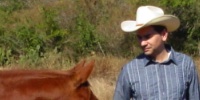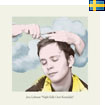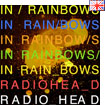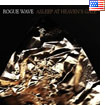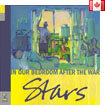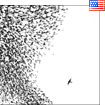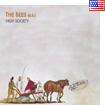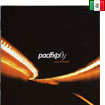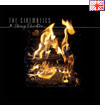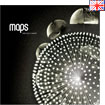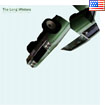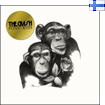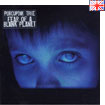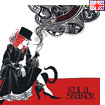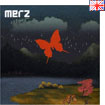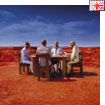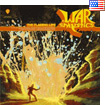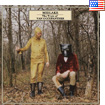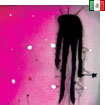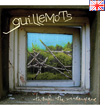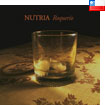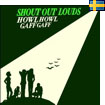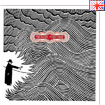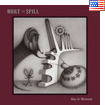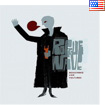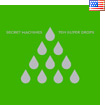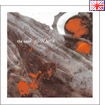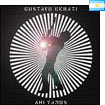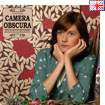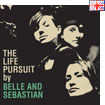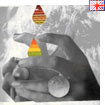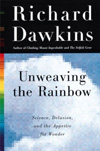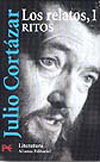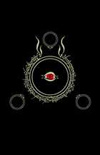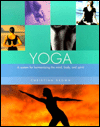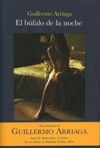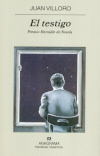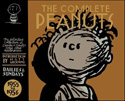Monday, May 21, 2007
And this is why I'm an agnostic
Siempre he tenido una vena de científico; de niño me gustaba leer libros de astronomía y de adolescente me volví un programador bastante bueno sin tener siquiera acceso a una computadora. Poco después de haber entrado a la universidad desarrollé un programa que resolvía ecuaciones diferenciales multi-variables utilizando técnicas de estructuras de datos avanzadas mucho antes de llegar a los cursos en los que se enseñaban esos conceptos. La vida y la falta de disciplina me han alejado de mis intereses científicos, reduciéndolos a la ocasional lectura breve de algún libro de Carl Sagan o Richard Dawkins (lo cual probablemente ni siquiera cualifica.) Sagan es uno de mis héroes personales, alguien que logró mucho en varias disciplinas que además tenía facilidad con las palabras y un genuino deseo de comunicar y compartir. Nunca olvidaré aquel domingo por la mañana, de adolescente, que estaba manualmente cambiando de canales en una tele vieja en blanco y negro y aleatoriamente caí en el canal 12, y vi mi primer episodio de "Cosmos", "La armonía de los mundos", aquel en el que Johannes Kepler y Tycho Brahe discuten acerca de la verdadera forma de las órbitas planetarias. Leí unos 3 libros de Sagan después de eso, pero hay uno que he estado cargando por alrededor de 10 años y al que nunca he llegado. Es uno de los últimos que escribió antes de morir (en el '95, me parece), "El Mundo y Sus Demonios: La ciencia como una luz en la oscuridad", y no puedo evitar pensar que cada año que pasa la premisa que encierra ese título se vuelve más elocuente y urgente. En fin, que es uno de los 5 libros que me he traído al departamento nuevo (los otros 4 son de naturaleza mucho más práctica) y he estado leyendo unas cuantas páginas antes de ir a dormir cada noche. No muy avanzado el libro, dice (cito de la versión traducida...) | I've always had this scientist vein in me; as a kid I liked to read astronomy books and as a teenager I became a pretty good programmer without even having access to a computer. In early college I developed a program that solved multi-variable differential equations using advanced data structure techniques long before I reached the courses where those concepts were taught. Life and a lack of discipline has pulled me away from my scientific interests, reducing it to the occasional brief reading of a Carl Sagan or Richard Dawkins book (which probably don't even qualify.) Sagan is one of my personal heroes, a grand achiever in many disciplines who was additionally graced with a gift for words and a genuine desire to communicate and share. I'll never forget the Sunday morning, as a teenager, I was manually changing channels on an old black and white TV and randomly landed on channel 12, and I saw my first "Cosmos" episode, "Harmony of the Worlds", the one where Johannes Kepler and Tycho Brahe square off over the actual shape of planets' orbits. I read 3 or so of Sagan's books after that, but there's one I've been carrying around for about 10 years or so and have never gotten to. It's one of the last ones he wrote before passing away (in '95, I think), "The Demon-Haunted World: Science as a Candle in the Dark", and I can't help but think that every year that goes by the premise encompassed by that title becomes more compelling and urgent. So anyway, it's one of the 5 books I've brought with me to my new apartment (the other 4 are of a much more practical nature) and I've been reading a few pages at a time each night before I go to sleep. Not too far into the book, he says (and this is me translating the Spanish version back into English...) | |
| " [...] Se dice que las Escrituras son de inspiración divina, una frase con muchos significados. Pero, ¿y si han sido fabricadas simplemente por humanos falibles? Se da testimonio de milagros, pero, ¿y si en lugar de eso son una mezcla de charlatanería, estados de conciencia poco familiares, malas interpretaciones de fenómenos naturales y enfermedades mentales? No me parece que ninguna religión contemporánea y ninguna creencia de la 'Nueva Era' tenga en cuenta suficientemente la grandeza, magnificencia, sutileza y complicación del universo revelado por la ciencia. El hecho de que en las Escritures se hallen prefigurados tan pocos descubrimientos de la ciencia moderna aporta mayores dudas en mi mente sobre la insiración divina. | " [...] It is said that the Scriptures are of divine inspiration, a phrase with many meanings. But, what if they were simply fabricated by flawed humans? There are testimonies of miralcles, but what if instead of that they are just a mix of charlatanry, little known states of consciousness, misinterpretations of natural phenomena and mental illnesses? I don't believe any contemporary religion or 'New Age' belief adequately acknowledges the grandeur, magnificence, subtlety and complication of the universe revealed by science. The fact that the Scriptures foreshadow so few of modern science's discoveries only increases my doubts regarding divine inspiration. | |
| Pero, sin duda, podría estar equivocado." | But, without a doubt, I could be wrong." |
Labels: Books, Personal, Sagan, Science
Sunday, November 05, 2006
Pure narcotic
| En Houghton las diferentes divisiones de la compañía solían competir entre ellas para ver cuál podía recaudar más dinero para una causa específica (he olvidado cuál era) colocando libros usados sobre mesas en los pasillos e invitando a la gente a tomarlos a cambio de un dólar. Uno de los libros que me llevé yo en algún momento es "Destejiendo el arco iris" por Richard Dawkins, un "popularizador de la ciencia" en la línea de Carl Sagan cuyo libro más famoso es probablemente "El gen egoísta", el libro que acuñó el término "meme" y sugería (entre otras cosas) que nuestros cuerpos son sólo vehículos para genes que buscan reproducirse. | At Houghton the different divisions of the company would used to compete with each other to see who could raise more money for a specific cause (I've forgotten which one) by placing used books on tables in the hallways and inviting people to pick them up and leave a dollar bill. One of the books I picked up at one point is "Unweaving the Rainbow" by Richard Dawkins, a "science popularizer" in the lines of Carl Sagan whose most famous book is probably "The Selfish Gene", the book that coined the term "meme" and suggested (among other things) that our bodies are just vessels for genes that want to reproduce. | |
| Bueno, apenas voy en el capítulo 4 y aunque se vende como un libro que empareja las delicias de la ciencia con las del arte, estoy encontrando que su enfoque primario es cómo el estudio--y específicamente, el "destejimiento"--de frecuencias y formas de onda nos revelan mucho del mundo material. El aplicar un análisis de Fourier a las frecuencias de luz que nos llegan de una estrella lejana, por ejemplo, nos dice mucho acerca de su edad, tamaño, distancia y composición física. Otro análisis de Fourier aplicado a una estela de pis dejada al lado de un camino en la India nos revela el tamaño del pene de un elefante y su distancia del suelo. (El ejemplo es suyo, no mío.) | Anyway, I'm only through the first 4 chapters and although it pitches itself as a book that pairs the delights of science with those of the arts, I'm finding its primary focus is on how studying--and specifically, "unweaving"--frequencies and waveforms gives us much insight into the material world. Applying a Fourier analysis on the frequencies of the light we see from a remote star, for example, can tell us a lot about its age, size, distance and physical composition. Applying a Fourier analysis on a trail of piss left behind on the side of a road in India can reveal the size of an elephant's penis and its distance from the ground. (It's his example, not mine.) | |
| Hay muchos poemas citados en el libro, principalmente de Keats (a quien encuentro difícil de leer), y de hecho el nombre del libro viene de un poema suyo que condena a Newton por "explicar" el arco iris y por ende arruinar el sentido de asombro y belleza que provoca contemplar uno--y es aquí donde entra el Sr. Dawkins para decir, "Espera, saber cómo funcionan estas cosas es aún más maravilloso y asombroso que no saberlo." Bueno, el capítulo 4, que trata con (las frecuencias en) el sonido, tiene una parte de un poema de Keats que se llama "Oda a un ruiseñor", en el que aparentemente entra en un trance narcótico escuchando el canto del ave. Dawkins continúa afirmando que la sensación de estar colocado que describe Keats puede no ser una idea muy descabellada, porque en la naturaleza el sonido tiene este efecto todo el tiempo. Y aquí cito directamente de su libro (la traducción es mía): | A lot of poems are quoted in the book, mostly from Keats (who I find difficult to read), and the name of the book actually comes from a poem of his that condemns Newton for "explaining" the rainbow and hence ruining the sense of beauty and wonder that comes from contemplating one--and this is where Mr. Dawkins steps in to say, "Wait, knowing how these things work is even more wondrous and awe-inspiring than not." Anyway, chapter 4, that deals with (frequencies in) sound, has a piece of a poem by Keats called "Ode to a Nightingale", where he apparently gets high by listening to the bird's song. Dawkins goes on to say that Keats' description of a narcotic experience provoked by a sound may not be such a wild idea, because in nature sounds have this effect all the time. And here I quote directly from his book: | |
| "Ruiseñores machos necesitan influir sobre el comportamiento de ruiseñores hembras [...] Algunos ornitólogos han descrito la canción como un transporte de información: 'Soy un macho de la especie Luscinia megarhynchos, en condiciones de inseminar, con un territorio, hormonalmente óptimo para aparear y construír un nido.' Sí, la canción contiene esa información, en el sentido de que una hembra que al escucharlo asume que es verdad y actúa podría beneficiarse. Pero hay otra manera de interpretarlo que siempre me ha parecido más vívida. La canción no es para informar a la hembra sino para manipularla. No es que la canción cambie lo que la hembra sabe, sino que está directamente cambiando el estado psicológico interno de su cerebro. Está actuando como una droga." | "Male nightingales need to influence the behaviour of female nightingales [...] Some orthinologists have thought of song as conveying information: 'I am a male of the species Luscinia megarhynchos, in breeding condition, with a territory, hormonally primed to mate and build a nest.' Yes, the song does contain that information, in the sense that a female who acts on the assumption that it is true could benefit thereby. But another way of looking at it has always seemed to me more vivid. The song is not informing the female but manipulating her. It is not so much changing what the female knows as directly changing the internal physiological state of her brain. It is acting like a drug." | |
| Continúa explicando que hay evidencia experimental de que los niveles hormonales de palomas y canarios hembras fluctúan cuando son expuestas a determinadas vocalizaciones de machos. Es extraño, porque parece tan obvio que el sonido y la música influyen en nuestro estado emocional y de conciencia, pero nunca lo había visto como una droga. Y eso es todo, me parecía algo que valía la pena compartir. (¡La otra cosa buena de este capítulo es que me ha dejado mucho más claro cómo las formas de onda representan en realidad al sonido!) | He goes on to explain there is experimental evidence that the hormone levels of female doves and canaries fluctuate when exposed to specific vocalizations of males. It's strange, because it seems so obvious that sounds and music have an influence on our state of mind and awareness, but I'd never thought of it as a drug. And that's it, I just thought this was worth sharing. (The other good thing about this chapter is that now I have a much better understanding of how waveforms actually represent sound!) |
Labels: Books, Personal, Science
